
«Ma molti preferiscono all’udire il guardare»: New Acoustemologies in Post-Unification Milan
Carlo Lanfossi – Elena Oliva (Università di Milano – Università di Firenze)
«The stubborn cult of the metropolis» (Persico 1934) – a recurrent acknowledgment for Milan –characterizes the discourses on the city already since the very first years after Unification. Steamed by a modernizer and cosmopolitan drive, which transformed the urban landscape, the «moral capital» of Italy set itself apart from other towns by creating new forms of entertainment production and consumption which followed a metropolitan spatiality. The benchmark was always Paris, from which Milan gathered and imitated not only the reorganization of performative spaces, but also a more general tendency to spectacularize the city itself.
This paper will examine two cases which reflect Milan’s obsession for the metropolis in its Parisian declination, where spatial, sonic, and social dimension are intertwined: the small wooden stage set up in the summer of 1866 at the public gardens for the Soirés Parisiennes operatic shows, and the pavilions and panoramas at the 1881 National Exhibition. They both exemplify two scopic and sonic dimensions, opposite but complementary, which satisfied the phantasmagorical drive typical of modernity. Our study is part of a research project of national interest (PRIN 2017) entitled Mapping Musical Life: Urban Culture and the Local Press in Post-Unification Italy (MML), which aims at reconstructing several aspects of musical life in the main urban centers of post-Unification Italy between 1866 and 1882, analyzed and visualized through thematic and interactive maps.
«Il culto testardo della metropoli» (Persico 1934) caratterizza la narrazione della città di Milano a partire dagli anni immediatamente successivi all’Unificazione. Attraversata da una spinta modernizzatrice e cosmopolita che trasforma i connotati del paesaggio urbano, la “capitale morale” d’Italia si distingue dagli altri centri per nuove forme di produzione e consumo spettacolare in sintonia con la spazialità metropolitana. Punto di riferimento è Parigi, da cui Milano riprende non solo la riorganizzazione degli spazi performativi, ma più in generale la tendenza a spettacolarizzare la città stessa.
La relazione esamina due casi emblematici che rispecchiano questa sorta di ossessione per la metropoli in chiave parigina, in cui si intrecciano le dimensioni spaziali, sonore e sociali: il piccolo teatro di legno delle Soirées Parisiennes eretto nel 1866 ai giardini pubblici, e i padiglioni dell’Esposizione nazionale del 1881. Tali casi esemplificano due dimensioni spaziali e acustiche opposte ma complementari, volte a soddisfare le pulsioni fantasmagoriche tipiche delle modernità. La ricerca è stata condotta nell’ambito del progetto di rilevante interesse nazionale (PRIN 2017) Mapping Musical Life: Urban Culture and the Local Press in Post-Unification Italy (MML), che ha l’obiettivo di ricostruire ampi segmenti della vita musicale dei più importanti centri urbani dell’Italia postunitaria, analizzati e visualizzati attraverso mappe tematiche interattive.
